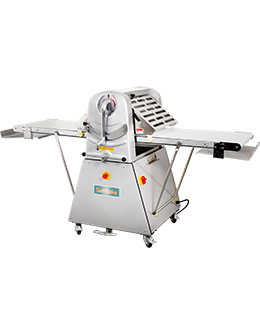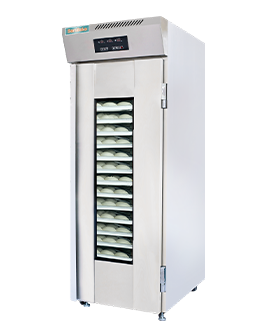Bread Slicer
Introduction to Bread Slicers

What is a Bread Slicer?
Why Slicing Matters in Commercial Baking
Manual vs. Automatic Bread Slicers
How Bread Slicers Work
Blade Mechanism
Bread slicers typically use a series of stainless-steel blades arranged in a parallel configuration. When activated, they cut the loaf cleanly and simultaneously into slices.
Load and Feed Process
You place the loaf into a guide tray, activate the mechanism, and the loaf gets pushed through the blade set in one smooth motion.
Slice Thickness Adjustment
Many commercial models let you choose the thickness—whether you want thick Texas toast or thin sandwich slices, you’ve got options.
Types of Bread Slicers
Countertop Slicers
Compact and efficient, these are perfect for small bakeries or shops with limited space.
Floor-Standing Models
Built for volume and durability, these can slice hundreds of loaves per hour and are often used in industrial or wholesale operations.
Continuous Feed Slicers
Best for high-volume bakeries. These slicers automate the entire process and can handle nonstop production without slowing down.
Benefits of Using a Bread Slicer
Time Efficiency
What takes a few minutes by hand can be done in seconds. That adds up when you're slicing dozens of loaves.
Uniform Slices
Every slice is identical in thickness—no more complaints about uneven sandwiches or broken slices.
Customer Convenience
Pre-sliced bread is easier to package, store, and serve—keeping customers happy and loyal.
Ideal Applications in the Bakery Business
Sliced Loaves for Sandwiches
Restaurants, delis, and cafes rely on uniform slices for building consistent sandwiches.
Packaged Retail Bread
Slicers make it easy to package loaves for retail shelves, whether in plastic bags or eco-friendly wraps.
Specialty and Artisan Breads
Even crusty, rustic loaves can be cleanly sliced with the right machine settings.
Key Features to Look for in a Bread Slicer
Blade Material and Durability
Stainless steel is king here. Look for serrated, hardened blades that last long and resist dulling.
Safety Features
Emergency stop buttons, blade guards, and safety interlocks are essential to protect your staff.
Slice Thickness Customization
Some models allow you to switch blade sets or adjust spacing for different slice widths.
Choosing the Right Bread Slicer for Your Bakery
Production Volume
If you're only slicing a few loaves per day, go small. For mass production, invest in high-speed models.
Bread Types
Softer loaves need gentle handling, while artisan or crusty breads require sturdier slicers with stronger motors.
Kitchen Space Constraints
Measure your available space before choosing. Some slicers are compact, while others need floor space and ventilation.
Setting Up and Operating a Bread Slicer
Installation Guidelines
Most slicers are plug-and-play, but always follow the manufacturer’s setup instructions to ensure safety.
Operating Instructions
Load the bread, select slice thickness (if available), activate the machine, and let the slicer do the work.
Maintenance Best Practices
Clean blades daily, inspect belts weekly, and replace dull blades promptly for top performance.
Bread Slicer Maintenance and Troubleshooting
Blade Cleaning and Replacement
Use a damp cloth and food-safe cleaner. Always turn off the power first. Replace blades once they dull or start tearing bread.
Dealing with Jammed Bread
Check for oversized loaves, incorrect loading, or dried crumbs blocking the blade path.
Reducing Noise and Vibrations
Make sure the slicer is on a level surface and check for loose screws or worn parts.
Cost vs. Value: Is a Bread Slicer Worth the Investment?
Upfront Costs
Expect to invest anywhere from $800 for a basic model to $10,000+ for industrial slicers.
Long-Term Savings
Labor savings, reduced waste, and improved product quality offer excellent ROI within months.
Leasing Options
If cash flow is tight, consider leasing with service and maintenance included.
Best Bread Slicer Brands and Models
Reliable Options for Small Bakeries
-
JAC Picomatic
-
Berkel MB Bread Slicer
-
Oliver 702-N
High-Performance Commercial Units
-
JAC Varia Pro
-
JEROS Automatic Bread Slicer
-
Daub Robocut 500
Hygiene and Food Safety
Easy-to-Clean Design
Look for machines with removable crumb trays and accessible blade areas.
Food-Grade Materials
Ensure all food contact surfaces are stainless steel or certified food-safe plastics.
Avoiding Cross-Contamination
Clean the slicer between different types of bread or use separate machines for allergen-sensitive products.
Comparing Bread Slicers with Traditional Knife Methods
Speed and Efficiency
What a knife does in minutes, a slicer can do in seconds—with no wrist strain.
Consistency and Safety
Blades stay in fixed positions, ensuring equal slice thickness and fewer cuts or accidents for your staff.
Innovations in Bread Slicer Technology
Self-Lubricating Blades
Some slicers now feature automatic lubrication to extend blade life and improve slice quality.
Digital Slice Control
Newer models offer programmable slice settings, touchscreens, and memory presets for different breads.
Conclusion
A bread slicer isn’t just a machine—it’s a game-changer for bakeries that value efficiency, precision, and presentation. Whether you're a cozy neighborhood bakery or a large-scale producer, this humble device can take your loaves to the next level. Invest in the right model, keep it maintained, and let it help you slice your way to success.
FAQs
Can I slice warm bread with a bread slicer?
It’s best to let bread cool before slicing. Warm loaves can squish or tear, even with a sharp blade.
How do I clean the blades safely?
Always unplug the machine first. Use a damp cloth and avoid immersing the slicer in water. Wear gloves for added safety.
Will it work on crusty artisan bread?
Yes! Choose a model with heavy-duty blades and adjustable pressure for tougher crusts.
What’s the ideal slice thickness for sandwiches?
Around 12mm (½ inch) is typical for sandwich bread, but this can vary based on your preference.
Is there a bread slicer for home use?
Yes, there are compact electric and manual models perfect for home kitchens or cottage bakeries.
- *Name
- *Title
- *Content
- Name:
- Vickey
- Tel:
+86-18862554041
- Email:
- sales@sambake.com
- Address:
- Xinxiang Industrial Park,Wuxi City,Jiangsu China






